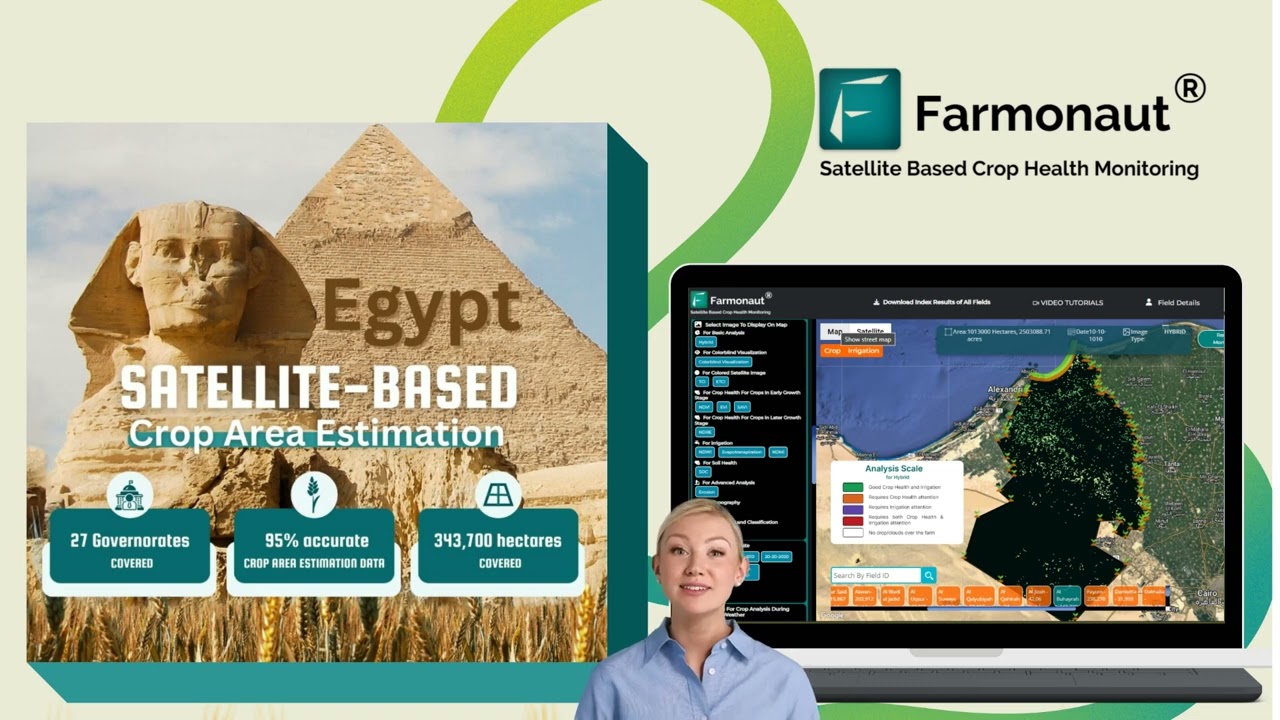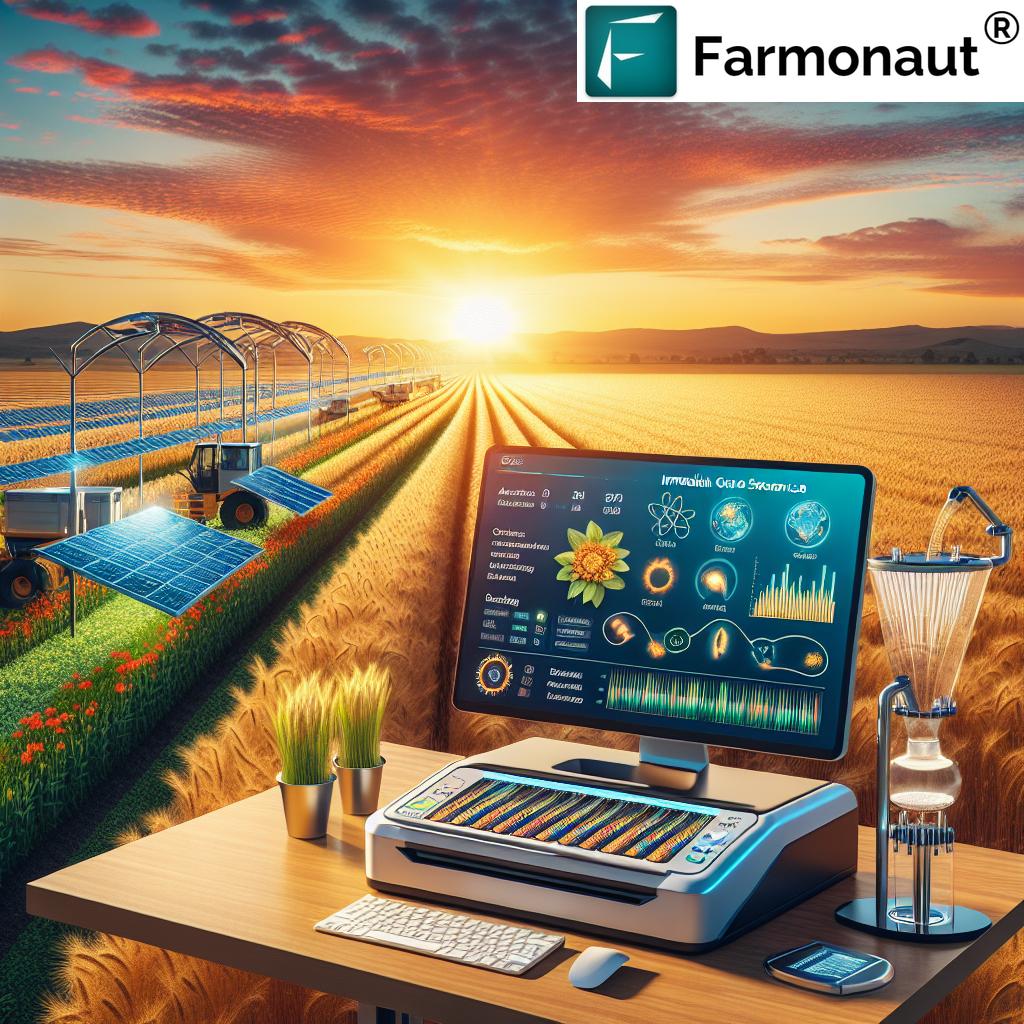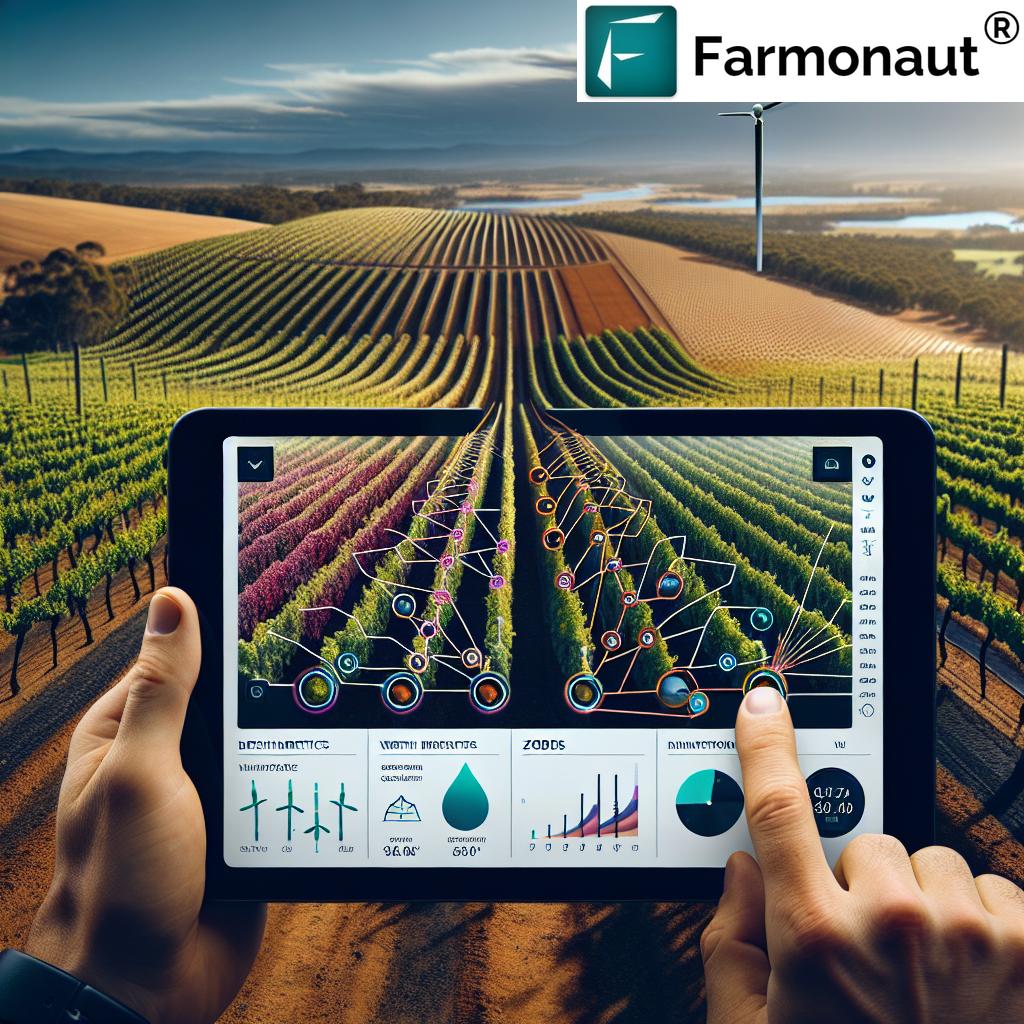Revolutionizing Australian Agriculture: Farmonaut’s Smart Farming Solutions for Sustainable Biosecurity and Export Growth

“Australia aims to achieve a $100 billion agricultural industry by 2030 through smart farming and biosecurity measures.”
In the vast expanse of Australia’s agricultural landscape, a revolution is underway. As we navigate the challenges of the 21st century, the integration of smart farming solutions and sustainable practices is reshaping the nation’s primary industries. At the forefront of this transformation is the Department of Agriculture, Fisheries and Forestry (DAFF), working tirelessly to foster a resilient and innovative agricultural sector.
In this comprehensive exploration, we delve into the intricate web of agricultural biosecurity measures, sustainable agriculture practices, and cutting-edge technologies that are propelling Australia towards its ambitious goal of a $100 billion industry by 2030. From the sun-baked outback to the lush coastal regions, we’ll uncover how precision farming technologies and drought-resistant techniques are revolutionizing crop monitoring systems and resource management across the country.
The Pillars of Australia’s Agricultural Revolution
Australia’s agricultural sector stands as a testament to innovation and resilience. As we embark on this journey of transformation, several key pillars form the foundation of our approach:
- Agricultural Biosecurity Measures: Safeguarding our unique ecosystems and agricultural assets
- Sustainable Agriculture Practices: Ensuring long-term viability and environmental stewardship
- Precision Farming Technologies: Harnessing data-driven insights for optimal crop management
- Drought-Resistant Farming Techniques: Adapting to Australia’s challenging climate conditions
- Agritech Innovations: Leveraging cutting-edge solutions to boost productivity and efficiency
As we delve deeper into each of these aspects, we’ll explore how they intertwine to create a robust framework for Australia’s agricultural future. Let’s begin by examining the critical role of agricultural biosecurity in protecting our nation’s primary industries.
Agricultural Biosecurity: The First Line of Defense
Australia’s unique geographical isolation has blessed us with a distinct ecosystem, free from many pests and diseases that plague other parts of the world. However, this isolation also makes our agricultural sector particularly vulnerable to biosecurity threats. The Department of Agriculture, Fisheries and Forestry (DAFF) plays a pivotal role in maintaining this delicate balance.
Key Components of Australia’s Biosecurity System:
- Pre-border risk assessment and intelligence gathering
- Border screening and inspection protocols
- Post-border surveillance and rapid response mechanisms
- Community engagement and education initiatives
These measures form a comprehensive shield, protecting our agricultural industry, natural environment, and economy from the potentially devastating impacts of exotic pests and diseases.
The Legislative Backbone: Biosecurity Act 2015
The Biosecurity Act 2015 stands as the cornerstone of Australia’s biosecurity system. This legislation provides a flexible and modern framework for managing biosecurity risks, encompassing:
- Risk assessment and management procedures
- Emergency response protocols
- Compliance and enforcement measures
- International cooperation and information sharing
By implementing these robust measures, we ensure that Australia’s agricultural exports maintain their reputation for quality and safety in global markets.
Sustainable Agriculture: Nurturing the Land for Future Generations
As stewards of the land, Australian farmers are increasingly embracing sustainable agriculture practices. These methods not only preserve our natural resources but also enhance productivity and resilience in the face of climate challenges.
Key Sustainable Agriculture Practices in Australia:
- Conservation tillage and soil management
- Integrated pest management (IPM)
- Water-efficient irrigation systems
- Crop rotation and diversification
- Agroforestry and carbon farming initiatives
These practices align with DAFF’s vision for a sustainable and profitable agricultural sector, contributing to both environmental conservation and economic growth.
The Role of Precision Farming Technologies
Precision farming technologies are revolutionizing Australian agriculture, enabling farmers to optimize resource use and maximize yields. These advanced tools provide unprecedented insights into crop health, soil conditions, and weather patterns.
Farmonaut’s Contribution to Precision Farming:
At the forefront of this technological revolution is Farmonaut, offering innovative solutions that empower Australian farmers with data-driven decision-making capabilities. Their satellite-based crop monitoring system provides real-time insights into vegetation health, soil moisture levels, and other critical metrics.
Key Features of Farmonaut’s Platform:
- Satellite-based crop health monitoring using NDVI (Normalized Difference Vegetation Index)
- AI-powered advisory system for personalized farm management
- Blockchain-based traceability solutions for supply chain transparency
- Resource management tools for optimizing water and fertilizer usage
By leveraging these advanced technologies, Australian farmers can make informed decisions that lead to increased productivity, reduced input costs, and improved sustainability.
“DAFF’s initiatives in precision farming and drought-resistant techniques have revolutionized crop monitoring across millions of hectares in Australia.”
Drought-Resistant Farming: Adapting to Australia’s Harsh Climate
Australia’s agricultural sector faces unique challenges due to its diverse and often harsh climate. Drought-resistant farming techniques have become essential in maintaining productivity and resilience in the face of water scarcity and extreme weather events.
Innovative Drought-Resistant Strategies:
- Development and adoption of drought-tolerant crop varieties
- Implementation of water-efficient irrigation systems
- Soil moisture conservation practices
- Climate-smart agriculture techniques
These strategies, combined with Farmonaut’s advanced crop monitoring systems, enable farmers to make data-driven decisions about water management and crop selection, enhancing their ability to withstand prolonged dry periods.
The Power of Digital Agriculture Platforms
Digital agriculture platforms are transforming the way Australian farmers manage their operations. These comprehensive tools integrate various data sources to provide holistic farm management solutions.
Farmonaut’s Digital Agriculture Platform:
Farmonaut’s platform stands out as a comprehensive solution for Australian farmers, offering:
- Real-time satellite imagery for crop monitoring
- Weather forecasting and historical data analysis
- Pest and disease prediction models
- Integration with IoT devices for precision agriculture
By leveraging these digital tools, farmers can optimize their operations, reduce risks, and make informed decisions that boost productivity and sustainability.

Enhancing Food Security and Boosting Exports
Australia’s agricultural sector plays a crucial role in both domestic food security and international trade. The adoption of smart farming solutions and sustainable practices is enhancing our ability to meet these dual objectives.
Impact on Food Security:
- Increased crop yields and livestock productivity
- Improved resilience to climate variability
- Enhanced traceability and quality assurance
- Reduction in post-harvest losses
Boosting Agricultural Exports:
- Meeting international quality and safety standards
- Improving supply chain efficiency
- Accessing new markets through innovative products
- Enhancing Australia’s reputation as a premium food producer
Farmonaut’s blockchain-based traceability solutions play a significant role in ensuring the transparency and integrity of Australia’s agricultural exports, building trust with international buyers and consumers.
The Export Control Act 2020: Facilitating Trade and Ensuring Compliance
The Export Control Act 2020 provides a modern legislative framework for Australia’s agricultural exports. This act streamlines export processes while maintaining the high standards that international markets expect from Australian products.
Key Aspects of the Export Control Act 2020:
- Simplified and flexible export certification processes
- Enhanced traceability requirements
- Improved compliance and enforcement measures
- Support for market access negotiations
By adhering to these regulations and leveraging Farmonaut’s advanced monitoring and traceability solutions, Australian exporters can confidently navigate international markets and capitalize on new opportunities.
The Role of Research and Innovation in Australian Agriculture
Research and innovation are the driving forces behind Australia’s agricultural advancements. The Australian Bureau of Agricultural and Resource Economics and Sciences (ABARES) plays a crucial role in providing evidence-based research and analysis to inform policy decisions and industry strategies.
Key Areas of Agricultural Research:
- Climate-resilient crop varieties
- Sustainable farming practices
- Emerging technologies in agriculture
- Market analysis and forecasting
Farmonaut’s commitment to innovation aligns with this research-driven approach, constantly refining and expanding its suite of smart farming solutions to meet the evolving needs of Australian agriculture.
Farmonaut’s Innovative Solutions for Australian Agriculture
Farmonaut’s suite of smart farming solutions is tailored to address the unique challenges and opportunities of Australian agriculture. By leveraging cutting-edge technologies, Farmonaut empowers farmers with the tools they need to thrive in an increasingly complex and competitive global market.
Key Offerings from Farmonaut:
- Satellite-Based Crop Monitoring: Providing real-time insights into crop health and development
- AI-Powered Advisory System: Offering personalized recommendations for optimal farm management
- Blockchain-Based Traceability: Ensuring transparency and trust in agricultural supply chains
- Resource Management Tools: Optimizing the use of water, fertilizers, and other inputs
These innovative solutions are accessible through Farmonaut’s user-friendly platforms:
For developers and businesses looking to integrate Farmonaut’s powerful data into their own systems, the company offers comprehensive API solutions:
The Future of Australian Agriculture: A $100 Billion Vision
As we look towards 2030, the Australian government’s vision of a $100 billion agricultural industry is within reach. This ambitious goal is underpinned by the integration of smart farming solutions, sustainable practices, and robust biosecurity measures.
Key Drivers of Growth:
- Increased adoption of precision agriculture technologies
- Expansion into new export markets
- Development of value-added products
- Enhanced productivity through research and innovation
- Improved resilience to climate variability
Farmonaut’s suite of smart farming solutions is poised to play a crucial role in this growth trajectory, providing Australian farmers with the tools they need to optimize their operations and compete on the global stage.
The Intersection of Policy, Science, and Technology
The future of Australian agriculture lies at the intersection of forward-thinking policy, cutting-edge science, and innovative technology. This synergy is essential for addressing the complex challenges facing the sector, including climate change, water scarcity, and evolving consumer preferences.
Key Areas of Focus:
- Policy frameworks that support innovation and sustainable practices
- Continued investment in agricultural research and development
- Collaboration between government, industry, and technology providers
- Education and skills development for the next generation of farmers
By embracing this holistic approach, Australia can build a resilient, sustainable, and globally competitive agricultural sector that meets the needs of both producers and consumers.
Australian Agricultural Innovations and Impacts
| Innovation Category | Technology/Practice Description | Estimated Adoption Rate (%) | Potential Impact on Productivity (%) | Contribution to Biosecurity | Alignment with DAFF 2030 Vision |
|---|---|---|---|---|---|
| Precision Farming | Farmonaut’s satellite-based crop monitoring | 35 | 15-20 | Early detection of pest/disease outbreaks | High – Supports data-driven decision making |
| Drought-Resistant Techniques | Water-efficient irrigation systems | 50 | 10-15 | Reduced water-borne disease spread | High – Enhances climate resilience |
| Digital Agriculture Platforms | Farmonaut’s AI-powered advisory system | 25 | 10-25 | Improved pest/disease management | High – Promotes smart farming practices |
| Blockchain Traceability | Farmonaut’s supply chain transparency solution | 15 | 5-10 | Enhanced product verification and recall efficiency | Medium – Supports export growth and food safety |
| Resource Management Tools | Farmonaut’s integrated farm management system | 30 | 10-20 | Optimized input use, reduced environmental impact | High – Aligns with sustainability goals |
Conclusion: A Sustainable and Prosperous Future for Australian Agriculture
As we’ve explored throughout this comprehensive overview, the future of Australian agriculture is bright, driven by the integration of smart farming solutions, sustainable practices, and robust biosecurity measures. The synergy between government initiatives, innovative technologies like those offered by Farmonaut, and the resilience of Australian farmers is paving the way for a $100 billion industry by 2030.
By embracing precision farming technologies, drought-resistant techniques, and digital agriculture platforms, we are not only enhancing productivity and efficiency but also safeguarding our unique environmental and economic interests. The legislative frameworks supporting these advancements, including key acts on biosecurity and export control, provide a solid foundation for growth and innovation.
As we move forward, the continued collaboration between policymakers, scientists, technologists, and farmers will be crucial in addressing the challenges and seizing the opportunities that lie ahead. With companies like Farmonaut at the forefront of agritech innovation, Australian agriculture is well-positioned to lead the world in sustainable, efficient, and profitable farming practices.
The revolution in Australian agriculture is not just about increasing yields or profits; it’s about creating a resilient, sustainable, and globally competitive sector that benefits farmers, consumers, and the environment alike. As we continue to innovate and adapt, we can look forward to a future where Australian agriculture not only meets the needs of a growing global population but does so in a way that preserves our land and resources for generations to come.
Farmonaut Subscription Plans
Frequently Asked Questions (FAQ)
- What is the role of DAFF in Australian agriculture?
DAFF (Department of Agriculture, Fisheries and Forestry) plays a crucial role in developing and implementing policies to support Australia’s agricultural sector, ensuring biosecurity, promoting sustainable practices, and facilitating international trade. - How does Farmonaut contribute to precision farming in Australia?
Farmonaut offers satellite-based crop monitoring, AI-powered advisory systems, and resource management tools that enable Australian farmers to make data-driven decisions, optimize resource use, and improve crop yields. - What are some key sustainable agriculture practices in Australia?
Key practices include conservation tillage, integrated pest management, water-efficient irrigation, crop rotation, and agroforestry. These methods help preserve natural resources while enhancing productivity. - How does the Biosecurity Act 2015 protect Australian agriculture?
The Biosecurity Act 2015 provides a framework for managing biosecurity risks, including risk assessment procedures, emergency response protocols, and measures to prevent the entry and spread of pests and diseases. - What is the significance of the $100 billion vision for Australian agriculture by 2030?
This vision represents a goal for substantial growth in the agricultural sector, driven by innovation, sustainable practices, and increased productivity. It aims to position Australia as a global leader in agricultural production and exports.
By addressing these challenges and opportunities, Australia’s agricultural sector is poised for a transformative future, blending traditional farming wisdom with cutting-edge technology and sustainable practices. As we continue to innovate and adapt, the vision of a $100 billion industry by 2030 becomes not just a goal, but a tangible reality within our reach.

















